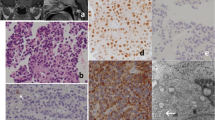Abstract
Clinically non-functioning pituitary adenomas account for about one-third of pituitary tumors. The majority of them are pathologically classified as gonadotropinomas or null-cell adenomas without hormonal expression. The rest represent silent corticotroph adenomas and plurihormonal tumors. Conservative therapy with dopamine agonists is effective in some cases only depending on the expression of dopamine 2 receptors (D2R). The aim of this study was to quantitatively estimate D2R expression in clinically non-functioning pituitary adenomas and correlate the results with adenoma type according to pathological classification. Out of the 87 adenomas investigated, 63 expressed gonadotropins, 7 were silent corticotroph adenomas, 7 were plurihormonal tumors, and only 6 did not express any pituitary hormone on immunohistochemical investigation. With the use of the reverse transcriptase PCR technique, D2R mRNA was expressed in all adenomas with very heterogeneous quantity. The expression was very low in corticotroph adenomas (relative median quantity after normalization to housekeeping gene 0.01) and lower in plurihormonal tumors (median 0.4) than in gonadotroph (median 1.3) and null-cell adenomas (median 1.9). The difference between corticotroph adenomas and plurihormonal tumors in comparison with other pathological types was statistically significant. The expression of D2R did not depend on the presence or absence of gonadotropins. We conclude that D2R expression is very low in corticotroph adenomas and significantly lower in plurihormonal tumors. The positivity of gonadotropins does not predict the D2R quantity.


Similar content being viewed by others
References
Jaffe CA (2006) Clinically non-functioning pituitary adenoma. Pituitary 9(4):317–321. doi:10.1007/s11102-006-0412-9
Osamura RY, Kajiya H, Takei M, Egashira N, Tobita M, Takekoshi S, Teramoto A (2008) Pathology of the human pituitary adenomas. Histochem Cell Biol 130(3):495–507. doi:10.1007/s00418-008-0472-1
Saeger W, Ludecke DK, Buchfelder M, Fahlbusch R, Quabbe HJ, Petersenn S (2007) Pathohistological classification of pituitary tumors: 10 years of experience with the German pituitary tumor registry. Eur J Endocrinol 156(2):203–216. doi:10.1530/eje.1.02326
Greenman Y, Stern N (2009) Non-functioning pituitary adenomas. Best Pract Res Clin Endocrinol Metab 23(5):625–638. doi:10.1016/j.beem.2009.05.005
Brochier S, Galland F, Kujas M, Parker F, Gaillard S, Raftopoulos C, Young J, Alexopoulou O, Maiter D, Chanson P (2010) Factors predicting relapse of nonfunctioning pituitary macroadenomas after neurosurgery: a study of 142 patients. Eur J Endocrinol 163(2):193–200. doi:10.1530/EJE-10-0255
Colao A, Di Somma C, Pivonello R, Faggiano A, Lombardi G, Savastano S (2008) Medical therapy for clinically non-functioning pituitary adenomas. Endocr Relat Cancer 15(4):905–915. doi:10.1677/ERC-08-0181
Neto LV, Machado Ede O, Luque RM, Taboada GF, Marcondes JB, Chimelli LM, Quintella LP, Niemeyer P Jr, de Carvalho DP, Kineman RD, Gadelha MR (2009) Expression analysis of dopamine receptor subtypes in normal human pituitaries, nonfunctioning pituitary adenomas and somatotropinomas, and the association between dopamine and somatostatin receptors with clinical response to octreotide-LAR in acromegaly. J Clin Endocrinol Metab 94(6):1931–1937. doi:10.1210/jc.2008-1826
Pivonello R, Matrone C, Filippella M, Cavallo LM, Di Somma C, Cappabianca P, Colao A, Annunziato L, Lombardi G (2004) Dopamine receptor expression and function in clinically nonfunctioning pituitary tumors: comparison with the effectiveness of cabergoline treatment. J Clin Endocrinol Metab 89(4):1674–1683
Greenman Y, Tordjman K, Osher E, Veshchev I, Shenkerman G, Reider G II, Segev Y, Ouaknine G, Stern N (2005) Postoperative treatment of clinically nonfunctioning pituitary adenomas with dopamine agonists decreases tumour remnant growth. Clin Endocrinol (Oxf) 63(1):39–44. doi:10.1111/j.1365-2265.2005.02295.x
Cap J, Cerman J, Nemecek S, Marekova M, Hana V, Frysak Z (2003) The influence of treatment with somatostatin analogues on morphology, proliferative and apoptotic activity in GH-secreting pituitary adenomas. J Clin Neurosci 10(4):444–448. doi:S0967586803000729
O’Toole D, Saveanu A, Couvelard A, Gunz G, Enjalbert A, Jaquet P, Ruszniewski P, Barlier A (2006) The analysis of quantitative expression of somatostatin and dopamine receptors in gastro-entero-pancreatic tumours opens new therapeutic strategies. Eur J Endocrinol 155(6):849–857. doi:10.1530/eje.1.02307
Al-Shraim M, Asa SL (2006) The 2004 World Health Organization classification of pituitary tumors: what is new? Acta Neuropathol 111(1):1–7. doi:10.1007/s00401-005-1093-6
Lamberts SW, Macleod RM (1990) Regulation of prolactin secretion at the level of the lactotroph. Physiol Rev 70(2):279–318
Bevan JS, Burke CW (1986) Non-functioning pituitary adenomas do not regress during bromocriptine therapy but possess membrane-bound dopamine receptors which bind bromocriptine. Clin Endocrinol (Oxf) 25(5):561–572
Ferone D, Lastoria S, Colao A, Varrella P, Cerbone G, Acampa W, Merola B, Salvatore M, Lombardi G (1998) Correlation of scintigraphic results using 123I-methoxybenzamide with hormone levels and tumor size response to quinagolide in patients with pituitary adenomas. J Clin Endocrinol Metab 83(1):248–252
Nishioka H, Tamura K, Iida H, Kutsukake M, Endo A, Ikeda Y, Haraoka J (2011) Co-expression of somatostatin receptor subtypes and estrogen receptor-alpha mRNAs by non-functioning pituitary adenomas in young patients. Mol Cell Endocrinol 331(1):73–78. doi:10.1016/j.mce.2010.08.011
Renner U, Arzberger T, Pagotto U, Leimgruber S, Uhl E, Muller A, Lange M, Weindl A, Stalla GK (1998) Heterogeneous dopamine D2 receptor subtype messenger ribonucleic acid expression in clinically nonfunctioning pituitary adenomas. J Clin Endocrinol Metab 83(4):1368–1375
Tateno T, Kato M, Tani Y, Oyama K, Yamada S, Hirata Y (2009) Differential expression of somatostatin and dopamine receptor subtype genes in adrenocorticotropin (ACTH)-secreting pituitary tumors and silent corticotroph adenomas. Endocr J 56(4):579–584. doi:JST.JSTAGE/endocrj/K08E-186
Acknowledgment
This work was supported by Charles University Grant Agency 79008 and Ministry of Health's Grant Agency NT11344-4/2010.
Conflict of interest
Filip Gabalec, Martin Beranek, David Netuka, Vaclav Masopust, Jiri Nahlovsky, Tomas Cesak, Jan Cap have nothing to declare.
Author information
Authors and Affiliations
Corresponding author
Rights and permissions
About this article
Cite this article
Gabalec, F., Beranek, M., Netuka, D. et al. Dopamine 2 receptor expression in various pathological types of clinically non-functioning pituitary adenomas. Pituitary 15, 222–226 (2012). https://doi.org/10.1007/s11102-011-0316-1
Published:
Issue Date:
DOI: https://doi.org/10.1007/s11102-011-0316-1




